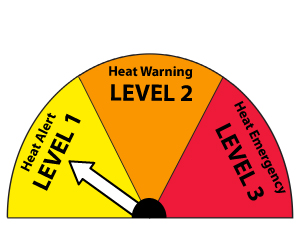Are You Ready for Extreme Heat This Summer?
Written by admin, May 29, 2014
May 29, 2014 – Public Health Activates Heat Alert and Response System for Peterborough City and County
 With summer quickly approaching and warmer temperatures imminent, Peterborough Public Health has activated its Heat Alert and Response System (HARS) to advise residents of the best way to protect their health when temperatures soar.
With summer quickly approaching and warmer temperatures imminent, Peterborough Public Health has activated its Heat Alert and Response System (HARS) to advise residents of the best way to protect their health when temperatures soar.
The Public Health monitors forecasted weather conditions daily, as provided by weather forecasters and Air Quality Ontario. Heat advisories will be issued to the media and key stakeholders and posted at www.peterboroughpublichealth.ca when a hot or humid air mass is forecast and heat related health effects may occur. Upon learning that a potential heat threshold is forecasted to occur within 24-48 hours, Public Health will activate the HARS.
The Public Health has adopted a series of extreme heat thresholds designed to advise the public, health professionals, and community service providers of appropriate measures they can take to reduce the health effects of hot, humid and smoggy weather. Information about these three advisory levels is available on the Extreme Weather – Heat webpage on www.peterboroughpublichealth.ca and outlined below:
Level 1: Heat Alert
A Level 1 Heat Alert is issued when the temperature is forecasted to reach 36ºC, with or without humidity, for two consecutive days with NO smog advisory. This level of alert reminds residents of the following core messages; to keep their home cool, stay out of the heat, keep the body cool and hydrated, assist others, and recognize the symptoms of heat exhaustion.
Level 2: Heat Warning
A Level 2 Heat Warning is issued when the temperature is forecasted to reach 36?C, with or without humidity for two consecutive days AND a smog advisory has been issued OR when the temperature is forecasted to reach 40?C, with or without humidity for two consecutive days with NO smog advisory OR at least two consecutive nights with minimum temperatures greater than 25ºC. This level of warning reminds residents of the core messages above in addition to providing further information on how and where to stay cool, advising suspension of strenuous outdoor activities, reminders to assist vulnerable groups, and to watch for further information through the media and Public Health website.
Level 3: Heat Emergency
A Level 3 Heat Emergency is issued when the temperature is forecasted to reach 36?C, with or without humidity, with contributing factors (such as a power outage) OR when the temperature is forecasted to reach or reaches 40?C, with or without humidity, for two consecutive days AND a smog advisory has been issued OR when the temperature is forecasted to reach or reaches 45?C, with or without humidity, for two consecutive days WITH OR WITHOUT a smog advisory OR when the Medical Officer of Health (MOH) has determined a heat emergency based on reports of heat related illness. This level of emergency reminds residents of all the core messages above in addition to asking residents to STOP all unnecessary strenuous outdoor activity, and to listen to media for further information and updates.
Extreme heat events are a potentially significant health risk and can have a severe impact on the health of vulnerable populations including infants, the elderly, shut-ins, persons with chronic diseases, the morbidly obese and the marginally housed. Heat related illnesses such as dehydration, heat cramps, heat exhaustion, and heat stroke are preventable. Most healthy people can tolerate a short period of hot and humid weather as long as they stay cool and drink plenty of fluids. It is important to be aware that some medications may increase the health risks from extreme heat events.
The Public Health encourages all stakeholders to advise vulnerable clients of the heat advisory system and precautions they can take to prevent and manage heat related illness.
How to Protect Yourself During Hot Weather:
- Drink lots of water and natural fruit juices even if you don’t feel very thirsty. Avoid alcoholic beverages, coffee and cola.
- Avoid going out in the direct sun or heat when possible. If you must go outside, stay in the shade as much as possible and plan to go out early in the morning or evening when it is cooler.
- Go to air conditioned or cool places such as shopping malls, libraries, community centres or a friend’s place.
- If you don’t have air conditioning, keep shades or drapes drawn and blinds closed on the sunny side of your home, but keep windows slightly open.
- Wear loose fitting, light clothing and a wide brimmed hat.
- Keep lights off or turned down low.
- Take a cool bath or shower periodically or cool down with cool, wet towels.
- Avoid heavy meals and using your oven.
- Avoid intense or moderately intense physical activity.
- If you are taking medication or have a health condition, ask your doctor or pharmacist if it increases your health risk in the heat and follow their recommendations.
Symptoms of heat exhaustion include:
- heavy sweating
- muscle cramps
- weakness
- headache
- fainting
- paleness, tiredness
- dizziness, nausea
Air conditioned public facilities are available to city and county residents seeking a place to cool off, such as shopping malls, community centres, arenas and libraries. Residents are advised to phone in advance to determine hours of operation.
-30-
For further information, please contact:
Wanda Tonus
Public Health Inspector
705-743-1000, ext. 285
